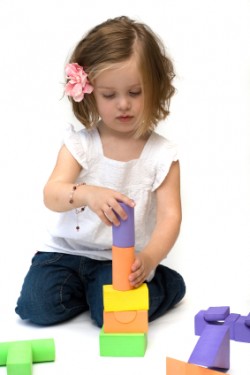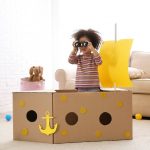 How do young children learn? The unanimous answer is that they learn by playing. Child Development specialists such as Vivian Gussin Paley, Erik Erikson and Jean Piaget all support that children need to play for the healthy development of their brains. While children are playing with hands-on-material or toys, this helps them to learn. The commonly used expression, “Play is the child’s work” is attributable to either Vivian Gussin Paley or Rena Wilson, Director of the Newcomb Nursery School in New Orleans.
How do young children learn? The unanimous answer is that they learn by playing. Child Development specialists such as Vivian Gussin Paley, Erik Erikson and Jean Piaget all support that children need to play for the healthy development of their brains. While children are playing with hands-on-material or toys, this helps them to learn. The commonly used expression, “Play is the child’s work” is attributable to either Vivian Gussin Paley or Rena Wilson, Director of the Newcomb Nursery School in New Orleans.
Research shows that 75% of brain development occurs after birth. In Rethinking the Brain: New Insights into Early Development by Rima Shore (NY: Families and Work Institute, 1997) some of the new thinking is that brain development hinges on a complex interplay between genes you are born with and the experiences you have: Early experiences have a decisive impact on the architecture of the brain and on the nature and extent of adult capacities. Early interactions don’t just create a context; they directly affect the way the brain is “wired.” Brain development is non-linear; there are prime times for acquiring different kinds of knowledge and skills. By the time children reach three, their brains are twice as active as those of adults. Activity levels drop during adolescence.
Children learn by observing and by trying to figure out why something works – with the help and support from teachers and peers. We have all heard that children “learn by doing.” Children need to participate in order to learn. This is often referred to as a “multi-sensory approach” to learning. Play is so important that it improves a child’s self esteem, fine and gross motor skills, and language and socialization skills.
Teachers and parents provide materials or toys that encourage children to play. You don’t need store bought materials to use for a child’s play – you can use whatever you have on hand. It is always wonderful to have developmentally appropriate toys, but children love to play with boxes, empty egg cartons, tissue paper, clothespins, old dress-up clothes and empty cereal boxes or other food containers. What is important is that children have these opportunities for creative and fantasy play. So much of what is called ‘good learning’ doesn’t need to be expensive. Children learn by playing with others.
Penelope Leach, in the New York Times said, “Vivian Paley’s books… should be required reading wherever children are growing.” Vivian Paley is one of my favorite authors on the topic of play. She was a nursery school and kindergarten teacher for 37 years, has received numerous awards and has received accolades from professionals in the field, such as Robert Coles and Howard Gardner.
We need to put play back in the classroom and make play an important part of family time together. Some of my own favorite years were spent being a nursery school and kindergarten teacher, observing, encouraging and knowing that young children were learning because of play. I hope sometime soon that we will see nursery school and kindergartens replace academics with play. It might take awhile because of all the governmental policies and standardized testing required today. Fantasy play is critical for the well being of our children today, tomorrow and in the future.
When you ask me what I’ve done at school today,
And I say “I played,”
Please don’t misunderstand me.
For, you see, I’m learning as I play.
I’m learning to be successful in work.
I’m preparing for tomorrow.
Today, I’m a child and my work is play.
Anita Wadley, 1974
Like what you read? Sign up for our free newsletter so you can be informed of the latest FREE webinars & teleclasses, parenting articles, & weekly raffles.
Patty Weiner is a mother and grandmother whose career spans over thirty-five years as a child life specialist, an educator, a child and family advocate and a health education specialist. She served as the Director of Child Life and Education Services at North Shore- Long Island Jewish Medical Center and was the founding Director of the Master’s Degree program in Child Life at Bank Street College of Education in New York. Patty is presently an educational and child life consultant practicing in Manhattan; an educational consultant for The Making Headway Foundation, a not-for -profit organization dedicated to children with brain and spinal cord tumors and their families; and a graduate school mentor in the Child Life program at Bank Street College. Patty’s work has been presented in a variety of professional forums and publications. She recently wrote a book, Taking Your Child To The Doctor or Hospital: Helpful Suggestions and Practical Tips to Make Your Child’s Visit More Comfortable.
The views and opinions expressed on this blog are purely the blog contributor’s. Any product claim, statistic, quote or other representation about a product or service should be verified with the manufacturer or provider. Writers may have conflicts of interest, and their opinions are their own.



